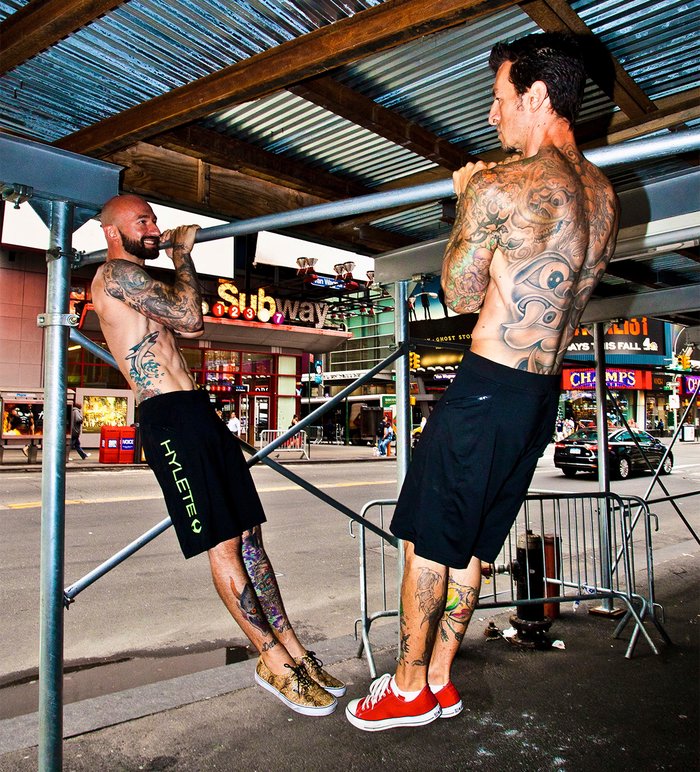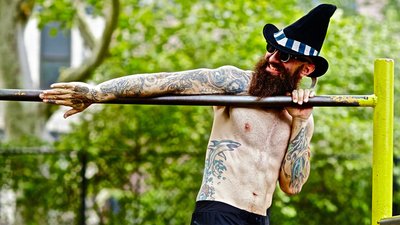My love affair with pull-ups began the very first time I managed to peek my chin over a horizontal bar at the tender age of 13. Since then, I've done more pull-ups than I could possibly count, and I've learned a lot of ways to up the ante on my pull-up game.
Many lifters are under the misconception that once you can do more than 10 pull-ups, the only way to progress the exercise is to hang extra weight from your body, such as a plate on a dip belt, a weighted vest, or a kettlebell hanging from your foot. While that is one way you can go, the advanced pull-up variations I'm about to share with you don't require the use of any external weight at all, which in most cases makes them much more accessible.
No matter how strong you think you are, I promise these variations will offer unique challenges that may test you in unexpected ways. Bring up your pull-up game!

Commando Pull-up
If you've done a lot of pull-ups, you probably know that it's good to mix up your hand position in order to hit your muscles from different angles. The commando pull-up is a perfect example of this principle in action. For this variation, you grasp the bar with your hands facing one another in a narrow, palms-facing grip.
In addition to the unusual hand placement, your body will wind up positioned in line with the bar, which means you will have to pull yourself toward the side on the way up in order to avoid hitting your head. This creates a unique challenge for your trunk as well as your grip due to the increased lateral instability. As such, newcomers to this exercise often have a hard time preventing the body from rotating. To keep this from happening, you will need to be especially mindful of bracing your core during both the pulling as well as the lowering phases.
When performing commando pull-ups, I recommend alternating which side of the bar your head passes with each rep. You can also alternate which hand is closer to your body on alternating sets of this exercise.
L-Sit Pull-up
For this variation, you keep your legs extended parallel to the ground throughout the entire range of motion. By changing the position of your legs, you not only increase the abdominal activation, you also change the leverage of the pull-up, creating more work for your arms, back, chest, and shoulders.
If you're having a hard time with this exercise, I recommend practicing hanging leg raises as an accessory movement. They will help you get a feel for holding your legs in front of your body while hanging from a bar.
Additionally, tight hamstrings can hold you back from achieving the L-sit pull-up, so you may need to work on improving your mobility before trying this exercise.
Like commando pull-ups, changing the position of your body will alter the stability required to maintain control throughout the full range of motion. It might feel different than you expect.
As always, just because I'm smiling doesn't mean these are easy.
Clapping Pull-up
If you are looking to build explosive power as well as strength, put your hands together for the clapping pull-up. This beast of an exercise is not only the gold standard of plyometric pulling movements, it's also a perfect precursor to the muscle-up.
In order to perform a clapping pull-up, you'll need to use your entire body to generate force. Pull the bar as powerfully as you can, driving your hips upward and leaning your torso back slightly. Once you get a feel for this, try letting go of the bar for a second at the top. Eventually, you'll be able to pull yourself fast enough and with sufficient force to remove your hands from the bar long enough to clap them together before catching the bar as you descend into your next rep.
As you become more comfortable with this exercise, you can try for multiple claps, or even a clap behind the back.
Archer Pull-up
The archer pull-up is an advanced variation that involves keeping one arm straight while relying primarily on the opposite side to do the bulk of the pulling. This means your torso will shift away from the extended arm as you pull, with the top position resembling an archer getting ready to fire an arrow. Another way you can think of this exercise is like a one-arm pull-up with a self-assist.
Begin with a wide grip, but aim to bend only one of your arms as you pull your chin over the bar. The hand of your straight arm may need to open and roll over the bar at the top of the range of motion, depending on your wrist mobility.
Archer pull-ups also require a lot of abdominal activation. Don't be surprised if you struggle to perform even a single clean rep on your initial attempts. This move is often more difficult than it appears.
Rotating-Grip Pull-up
Grip strength is a vital component of any type of pull-up, but performing pull-ups on a rotating bar or a pair of spinning handles elevates the grip challenge to a surprisingly intense level.
Mind you, I'm not talking about the kind of handles that rotate in the transverse plane, allowing you to switch from an overhand to underhand grip as you pull. Those types of grips generally make pull-ups easier. I'm referring to a bar or handle that spins around itself, so you can't get a good grip on it. Bonus points if your revolving grip handles are extra thick!
What makes this type of pull-up so challenging? Well, think about what you do when you're hanging from a bar and start to lose your grip. Most people instinctively try to choke their hands up a bit higher on the bar for more surface contact and improved leverage.
When you try to do this on a rotating handle, however, it just spins right back to where it was, forcing you to grip from a position of unfavorable leverage. You have to grip a revolving bar from below; it's impossible to utilize any type of false grip on a handle that spins.

